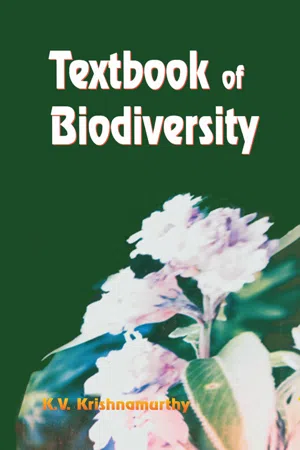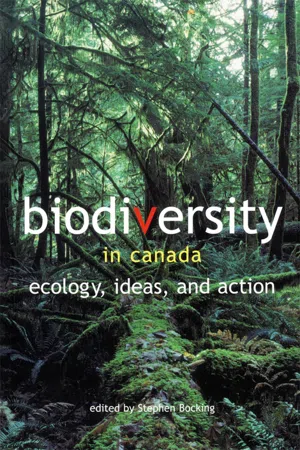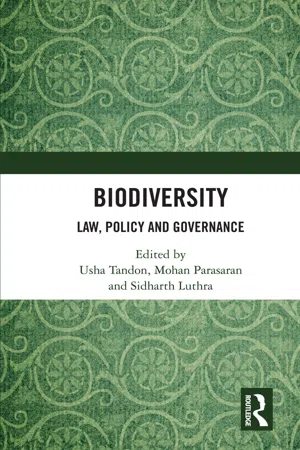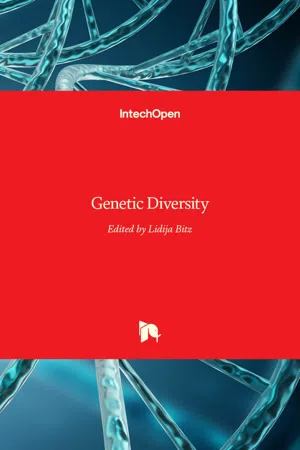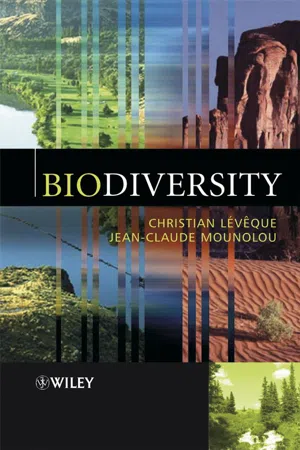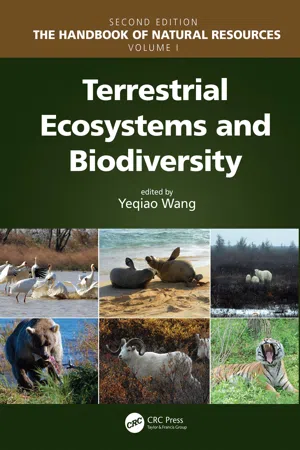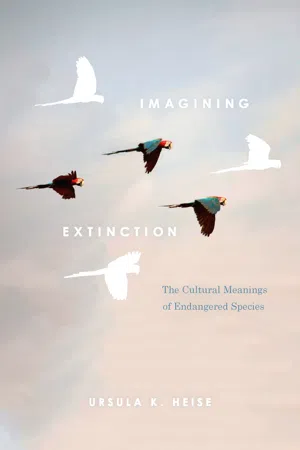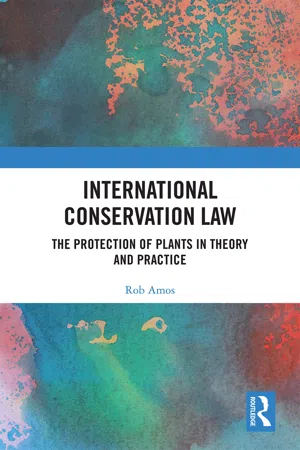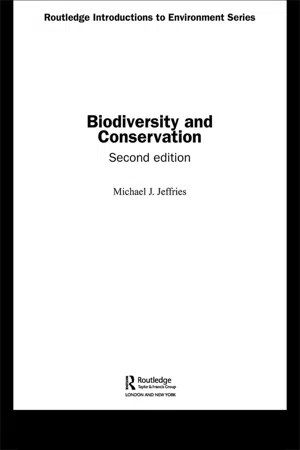Geography
Biodiversity Legislation
Biodiversity legislation refers to laws and regulations aimed at protecting and conserving the variety of life on Earth. These laws often focus on preserving ecosystems, species, and genetic diversity. Biodiversity legislation can include measures such as protected area designations, species conservation plans, and regulations on habitat destruction and pollution to safeguard the natural environment and its inhabitants.
Written by Perlego with AI-assistance
Related key terms
1 of 5
10 Key excerpts on "Biodiversity Legislation"
- eBook - PDF
- K V Krishnamurthy(Author)
- 2003(Publication Date)
- CRC Press(Publisher)
Only a few decades ago, however, environmental law emerged as a distinct branch of law in order to regulate the activities of man towards the biotic and abiotic components of the environment. Effective legal protection for biodiversity can be provided only after a synthesis of social structure, policy and regulation has been effected. Society must first realise that the fuel for this process is an understanding of the biotic community and our place in this community; we must realise that we are only fellow members of the Earth's biotic community. Biodiversity laws differ from other laws in that they, instead of governing relationships between persons or between persons and society, strive to protect biodiversity, the destruction of which affects all of humanity. However, the implementation and enforcement problems of these laws are almost insurmountable. In several countries, a large number of environmental laws and treatises are really 'paper tigers' because governments lack the will or ability to enforce them. The most noteworthy example is the lack of enforcement of a legal ban on clearing tropical forests. In other words, there is no use of legislating biodiversity protection until our society is 'structured to make adherence to such protections possible' (Given 1996). Throughout the world, biodiversity laws started as specialised sub-branches of agriculture and/or forestry laws; initially they dealt specifically with regulation of the exploitation of wild species and the establishment of protected areas. Only slowly did they evolve as specialised biodiversity laws extended into laws pertaining to planning and land-use legislation. - eBook - PDF
Biodiversity in Canada
Ecology, Ideas, and Action
- Stephen Bocking(Author)
- 2019(Publication Date)
- University of Toronto Press(Publisher)
This is the quintessential biodiversity legal scenario, including a general direction from the International Biodiversity Convention to protect species at risk; a constitutional dispute between the federal government and provinces as to who should do it and how; industry C A N A D I A N B I O D I V E R S I T Y A N D T H E L A W 2 9 7 P resistance to regulation yet inadequate government support for vol-untary stewardship; and environmentalists' concerns that decisions be based on science, and about the extent of governmental discretion given past inaction and reduced funds and staff. Law has many implications for how Canadians interact with other life forms. Biodiversity law can be grouped into four main areas: pro-tection of species; landscape issues, such as protected areas and plan-ning; genetics; and sustainable use. Each area will be discussed below. However, we begin with some background on our Canadian legal sys-tem. Law is usually seen as the familiar rules and regulations that tell us what we can or cannot do, but it is much more than that. Law can assist in nature conservation, sustainable use, and fair sharing. For example, law can: establish organizations, their composition, man-date, and activities; recognize or authorize individuals and organiza-tions; help settle disputes and determine rights and responsibilities; set out principles, goals, and priorities to guide decision-making; declare or reflect publicly held social and ethical values; provide for funding mechanisms; alter the marketplace and create financial incentives for action; and educate people about the law, by making cross-references and clarifying relationships among legislation. Law derives from many sources. It can arise from international agreements or customary practices in the world community, such as the Convention on Biological Diversity and Agenda 21, two products of the 1992 Earth Summit. - eBook - ePub
Biodiversity
Law, Policy and Governance
- Usha Tandon, Mohan Parasaran, Sidharth Luthra(Authors)
- 2017(Publication Date)
- Routledge India(Publisher)
In this context, the role of these countries, being biodiversity-rich countries, has been continuously looking forward in the global governance of biodiversity. Hence, this chapter aims to explore their laws, policies and diplomacy addressing biodiversity conservation and management in the contemporary age. It tries to examine the constitutional provisions, legislations, regulations, plans and policies of these countries in this regard. This chapter proposes that these countries have greater responsibility to conserve and manage their biodiversity for the overall development in the contemporary period. They should amend the existing legislations and improve the plans and policies for better biodiversity conservation and management; actively participate in the events and negotiations formalizing the practice and procedure for conservation, access, transfer and equitable sharing of the benefits of the biological resource; and take initiative and leadership through diplomacy in attaining the objectives of the CBD and other multilateral environmental agreements (MEAs) at the regional and national levels.I. Biodiversity conservation and management
Biodiversity refers to the variability among living organisms from all sources, including terrestrial, marine and other aquatic ecosystems.6 It is estimated that there are about ‘fourteen million plant and animal species of which only 1,750,000 are known to science’.7 These are considered immensely valuable, especially in maintaining ecological balance and fulfilling human needs. It is said that biodiversity on the planet is a precious gift from God to humans. Human and animal are directly dependent on biodiversity, which could be sustained for the future only when it is well conserved and adequately managed. However, the conservation as well as management of biodiversity has been transformed recently in the international agenda, as evident from the practices of community-based conservation and management in developing nations.8 - eBook - PDF
- Lidija Bitz(Author)
- 2017(Publication Date)
- IntechOpen(Publisher)
The users may be promoted to the higher user groups provided that they increase reliability percent of the biological diversity data approved by the System Administrator [43]. Some regulations in the legislation about conservation on biodiversity and provisions on these regulations are briefly as the following: The 181–184th acts of Turkish Criminal Law embody crimes against environment. According to this, emitting wastes deliberately to soil, water, or air thus damaging the environment is considered a crime and the penalties are increased in the event of committing these events with wastes causing the emergence of illnesses hard to cure for human beings and animals, the atrophy of reproduction ability and the change on natural features of animals and plants. There are some other special legal regulations. It is possible to encounter provisions about conservation on biodiversity in 1956 Forest Law about forests, constituting one of the habitats of wild life and endemic plants. On the 25th Act of the law, in sum, the following statement is involved: “General Directorate of Forestry assigns forests and forest areas to the use of science, protects the nature, meets various sports and relaxation needs of the society, enables touristic activities, and separates, organizes, directs and in case of need, manages forests and forest areas as national parks, nature parks, natural monuments, nature conservation areas and forest recreation areas.” On the 14th Act of Forestry Law, some conservation precautions towards saving forests are included, as well [44]. Concerning the protection of biodiversity, on the 9/a act of Environmental Law, it is stated that protection of biodiversity and ecosystem, constituting the natural environment, is fundamen‐ tal and the essentials of the protection and usage of biodiversity will be determined by taking the opinions of local administrations, universities, nongovernmental organizations, and other related institutions. - eBook - PDF
- Christian Lévêque, Jean-Claude Mounolou(Authors)
- 2004(Publication Date)
- Wiley(Publisher)
With variations according to country, applications of the Convention on Biological Diversity address biological, ecological and environmental aspects of the issue. At the national level, policies on matters of genetic resources and agriculture take their cue from the FAO propositions, while legislation governing intellectual property and commerce follows the recommendations of the WIPO and WTO. On the other hand, the way in which national policies are structured and coordinated also bears the stamp of national cultural identity. It is a delicate task to reconcile the different and sometimes contradictory demands involved in such tasks as inventorying national patrimony, regulating the protection of natural sites, defining new rights, changing the rules of land use and property, etc., not to mention the pursuit of development, which also remains a priority. In Finland or France, the sense of cohesion is trad- itionally strong. In many European countries, as in Canada and the Citing the Convention on Biological Diversity and the concept of national sovereignty, Thailand has enacted national legislation estab- lishing new rules for the protection of and access to genetic resources, biological diversity, and traditional medicinal plants. The exact wording of this national law was still in deliberation when the Ameri- can government demanded that it be outlawed by the World Trade Organisation. The USA protested against what it saw as protectionism to the detriment of medical research and claimed that national control over genetic resources constituted an impediment to free trade . . . . We are still far from sharing the benefits of biodiversity in a just and equitable manner . . . 10 . 10 FROM THEORY TO PRACTICE 261 USA, the responsible administrations still leave considerable leeway for private as well as public action. In many developing countries, a coherent conservation policy has yet to be developed. - eBook - PDF
- Peter, K V(Authors)
- 2018(Publication Date)
- Daya Publishing House(Publisher)
Chapter 1: Convention on Biological Diversity vis-à-vis Biological Diversity Act of india N. Sivaraj, S.R. Pandravada and V. Kamala ICAR-National Bureau of Plant Genetic Resources, Regional Station, Hyderabad – 500 030, Telengana E-mail: [email protected] Biological diversity or biodiversity is the term attributed to the variety of life on Earth and the natural patterns it forms. The biodiversity, what we see today is the fruit of billions of years of evolution, shaped by natural processes and increasingly, by the infuence of humans. It forms the web of life of which we are an integral part and upon which we so fully depend upon. So far, about 1.75 million species have been identifed, mostly small creatures such as insects and Scientists reckon that there are actually about 13 million species, though estimates range from 3 to 100 million (Angelo Cropper, 1993). Biodiversity also includes genetic differences within each species - for example, between varieties of crops and breeds of livestock. Yet another aspect of biodiversity is the variety of ecosystems such as those that occur in deserts, forests, wetlands, mountains, lakes, rivers and agricultural landscapes. “ Earth provides enough to satisfy every man’s needs, but not every man’s greed ” – Mahatma Gandhi “ Biodiversity is what we need; conserving biodiversity is a good deed ” – Shreemayi, School student, New Delhi Biodiversity is crucial to the survival of all ecosystems, life forms and This ebook is exclusively for this university only. Cannot be resold/distributed. microorganisms on our earth (Tiwari, 2006). It is an interdependent, closely interlinked life system that binds all life on planet together in a delicate and intricate web where each strand plays a crucial role and depends upon the other for survival. In each ecosystem, living creatures, including humans, form a community, interacting with one another and with the air, water, and soil around them. - eBook - ePub
- Yeqiao Wang(Author)
- 2020(Publication Date)
- CRC Press(Publisher)
4 Biodiversity: Conservation Nigel E. Stork Griffith University Introduction The Dimensions of Biodiversity: How Much Do We Know? Phyletic and Genetic Diversity Species Diversity: How Many Species Are There and How Many Have Been Described? Where Is Biodiversity Found? Conservation Protected Areas Threats to Biodiversity and the Environment Conservation Biology Global Action Extinction Rates Conclusion References BibliographyIntroduction
The term “biodiversity,” the contraction of “biological diversity,” came into common usage following the signing of the Convention on Biological Diversity at the United Nations Conference on Environment (commonly known as the “Earth Summit”) in Rio de Janeiro in 1992. This Convention was signed by 193 nations (ratified by 168) and is one of the most widely recognized international treaties. Prior to the Convention, biodiversity was a rapidly developing concept among scientists. It was first featured in a book edited by Wilson and Peters [1] and signified a rising concern for the world’s fauna and flora. This also followed several decades of concern for the world’s environment as the conservation movement also began to grow.But what is biodiversity? The Convention defines biodiversity as “the variability among living organisms from all sources including terrestrial, marine and other aquatic ecosystems and ecological complexes of which they are a part; this includes diversity within species, between species and ecosystems.” However, biodiversity means different things to different people and is more complex than this simple definition. It encompasses not just hierarchies of taxonomic and ecological scales and other more or less independent scales such as geographic scales and scaling in body size of organisms. A search on Google for the definition of biodiversity comes up with an interesting word cloud (Figure 4.1 ).FIGURE 4.1 (See color insert .)This word cloud results from a Google search for the definition of biodiversity. (http://thepimmgroup.org/1022/defining-biodiversity-toward-a-consensus/ - eBook - ePub
Imagining Extinction
The Cultural Meanings of Endangered Species
- Ursula K. Heise(Author)
- 2016(Publication Date)
- University of Chicago Press(Publisher)
But even granting that the American and German laws for the protection of endangered species may be shaped by practical implementations more than is apparent in their original formulations, their conceptual approach to the problem remains strikingly different. The cultural and historical reasons for this difference emerge more clearly when we consider that the German law not only concerns itself with biodiversity more than with endangered species, but also does not in fact mention either biodiversity or endangered species in its title. The law is called Bundesnaturschutzgesetz for short (Federal nature protection act), but its full title is Gesetz über Naturschutz und Landschaftspflege (Act on nature protection and landscape management).The law’s three goals, according to §1, are quite broad: to ensure biological diversity; to ensure the performance and functioning of ecosystems, including the sustainable use of natural resources; and to ensure the diversity, particularity, beauty, and recreational value of landscapes.11 The second goal, ensuring ecosystem functioning, seems particularly general, given that this law is not centrally concerned with clean air or water, with mining, fishery, or agriculture, all areas that are covered by other laws. At its core, as the third goal reveals, the act aims at the protection of spaces (including oceans) and of species. The formulaic phrase “Natur und Landschaft” (nature and landscape), repeated obsessively in this and other legal texts, as well as its companion “Naturschutz und Landschaftspflege” (nature conservation and landscape management) convey this combined concern with species and spaces.The concept of “Landschaft” might at first sight appear to function as the equivalent of the “critical habitat” that the American Endangered Species Act includes as part of the conservation of plants and animals. But even a cursory look at the Federal Nature Protection Act reveals that it dedicates as much space to the protection of landscapes as to that of species, including a long list of specific conservation designations: “Naturschutzgebiete,” “Naturdenkmäler,” “Nationale Naturmonumente,” “Biosphärenreservate,” and “Landschaftsschutzgebiete” (nature conservation areas, natural monuments, national nature monuments, biosphere reserves, landscape protection areas), to name a few. Neither simply critical habitat for endangered species nor merely natural space seen in its pictorial or aesthetic dimension, as the English cognate landscape might suggest, Landschaft - eBook - ePub
International Conservation Law
The Protection of Plants in Theory and Practice
- Rob Amos(Author)
- 2020(Publication Date)
- Routledge(Publisher)
Part 2 The international legal framework for the protection of plantsPassage contains an image
2 Global approaches to the protection of plants
Tensions in international conservation law
International law refers to biodiversity by several terms that have varying degrees of legal significance.1 Chapter 1 demonstrated how the instrumental value of nature largely underpins international conservation law and policy. Framing nature in terms of resources that are subject to the sovereignty of states implies that conservation is primarily an issue for individual nations, as central to the principle of permanent sovereignty is that states are free to ‘exploit their own resources pursuant to their own environmental policies’.2 Yet the law also recognises, at least in preambular statements, that biodiversity conservation is an issue that transcends states’ borders and is a legitimate area of common concern.3 Inevitably, this causes tension in international conservation policies, with the desire of states to safeguard their sovereignty having to be reconciled with the growing assertiveness of the wider international community in environmental matters.41 P. Birnie, A. Boyle and C. Redgwell, International Law & the Environment (3rd edition, Oxford: Oxford University Press, 2009), 657–662.2 Article 3 of the Convention on Biological Diversity Rio de Janeiro, 5 June 1992, in force 29 December 1993, 31 ILM 822 (1992).3 Birnie, Boyle and Redgwell, (n 1), 657.4 D. French, ‘Common Concern, Common Heritage and Other Global(-ising) Concepts: Rhetorical Devices, Legal Principles or a Fundamental Llegal Challenge?’, in M. Bowman, P. Davies and E. Goodwin (eds), Research Handbook on Biodiversity and Law (Cheltenham: Edward Elgar, 2016), 336–337.This tension is manifested in the 1992 Convention on Biological Diversity, the main global conservation treaty. I begin this chapter by arguing that the design and direction of this regime, including the system of thematic programmes, cross-cutting issues and major groups that have been developed to supplement the broad provisions of the Convention’s text, frustrate its ability to conserve plants. States have proven reluctant to cede any power or authority to supranational bodies, instead insisting on what they consider to be their inalienable sovereign rights.5 - eBook - ePub
- Michael J. Jeffries(Author)
- 2006(Publication Date)
- Routledge(Publisher)
Articles 20 and 21 of the Rio treaty deal with financial resources and financial mechanisms respectively. Paragraph 1 of Article 20 states, ‘each Contracting Party undertakes to provide, in accordance with its capabilities, financial support and incentives in respect of . . . the objectives of this Convention’, followed by paragraph 1 of Article 21, ‘There shall be a mechanism for the provision of financial resources to developing country parties’. The United Kingdom’s official publication of the treaty includes this revealing caveat at the end: ‘The government of the United Kingdom . . . declare their understanding that the decisions to be taken by the Conference of Parties under para. 1 of Article 21 concern “the amount of resources needed” by the financial mechanism, and that nothing in Article 21 authorises the Conference of parties to take decisions concerning the amount, nature, frequency or size of the contributions of the Parties’. France and Italy added similar nervous notes.National Legislation
National legislation differs in detail between countries but common themes recur. Laws can be categorised into two approaches: first, regulatory, involving prohibition or restriction, backed by punishment versus non-regulatory relying on positive incentives, and second, the focus for laws on genetic resources, species, habitats or destructive activities.Regulation
Genetic resources
Legislation to conserve genetic resources is a recent development, with little precedent to build upon and an indicator of changed attitudes to conservation. Protection is typically combined with regulation of exploitation and sharing the benefits. Regulation of genetic biodiversity is founded in the Rio Convention’s statement of the sovereign rights of nations to control access and use of genetic resources, vividly revealing the tensions between source and recipient countries. Source countries face three tasks: regulation of collection, including sharing information and participation of local people; regulations for sharing technologies and benefits; establishment of regulatory authorities to oversee compliance. In addition source countries will succeed only if recipient countries develop complementary legislation to allow enforcement.Species protection
Traditional custom, taboo and law protected some game animals in many countries, with restrictions by season, catch, method or entitlement. The majority of species went unprotected, often held to be the property of the landowner. The first species-specific law was drawn up in the Swiss Canton of Zug in 1911, to regulate collection of the edelweiss (Leontodon alpinum
Index pages curate the most relevant extracts from our library of academic textbooks. They’ve been created using an in-house natural language model (NLM), each adding context and meaning to key research topics.
